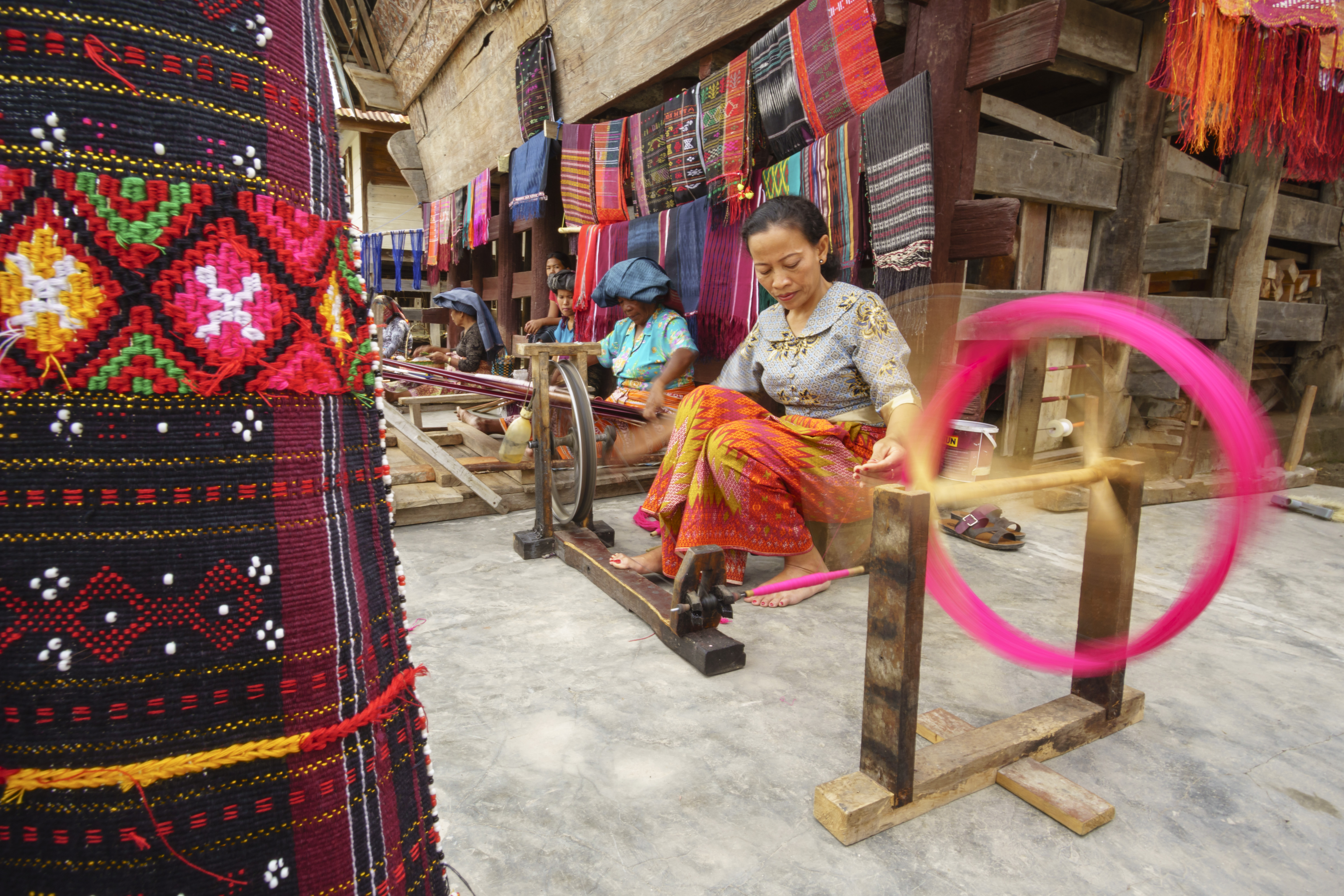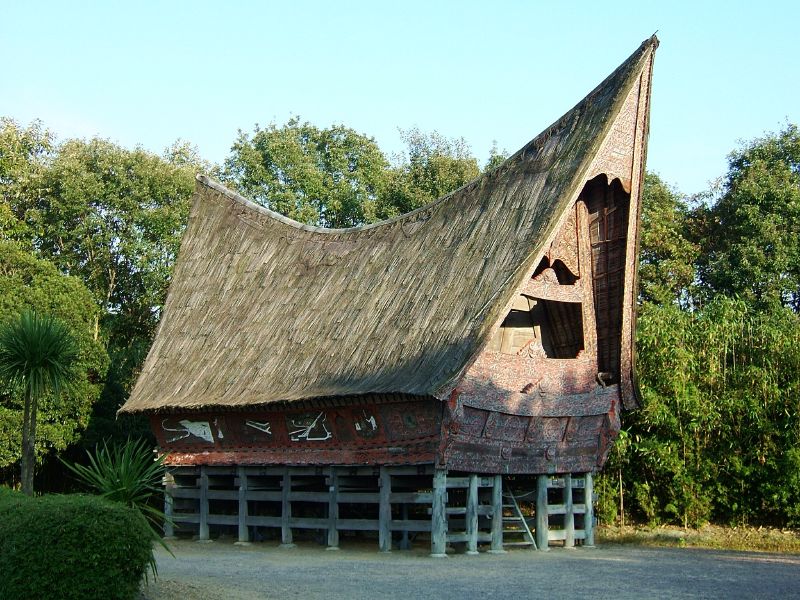|
Ulos
Ulos is the traditional ''Tenun'' fabric of the Batak people of North Sumatra in Indonesia. Different kinds of ulos have different ceremonial significance. The ulos is normally worn draped over the shoulder or shoulders, or in weddings to ceremonially bind the bride and groom together. Ulos are traditionally hand woven and in the case of higher-quality examples are significant family heirlooms, to be worn at important events, such as funerals and weddings. With increasing modernisation has come the decline in significance of the ulos, with many varieties no longer in demand. History According to the Batak people, there are three sources of warmth for humans; Sun, Fire and Ulos. Why is ulos a source of warmth? Ulos is said to be a source of warmth because they were living on cold mountains. This natural condition makes sunlight insufficient to give warmth especially at night. Then, they created something that is able to give them warmth, also believed to be able to give the men ... [...More Info...] [...Related Items...] OR: [Wikipedia] [Google] [Baidu] |
Cotton
Cotton is a soft, fluffy staple fiber that grows in a boll, or protective case, around the seeds of the cotton plants of the genus ''Gossypium'' in the mallow family Malvaceae. The fiber is almost pure cellulose, and can contain minor percentages of waxes, fats, pectins, and water. Under natural conditions, the cotton bolls will increase the dispersal of the seeds. The plant is a shrub native to tropical and subtropical regions around the world, including the Americas, Africa, Egypt and India. The greatest diversity of wild cotton species is found in Mexico, followed by Australia and Africa. Cotton was independently domesticated in the Old and New Worlds. The fiber is most often spun into yarn or thread and used to make a soft, breathable, and durable textile. The use of cotton for fabric is known to date to prehistoric times; fragments of cotton fabric dated to the fifth millennium BC have been found in the Indus Valley civilization, as well as fabric remnants dated back ... [...More Info...] [...Related Items...] OR: [Wikipedia] [Google] [Baidu] |
Kebaya
A kebaya is an upper garment traditionally worn by women in Southeast Asia, notably in Brunei, Indonesia, Malaysia, Singapore and Southern Thailand. Outside of Southeast Asia, it is worn by Javanese, Malays and Portuguese Eurasians in Australian Cocos Islands and Christmas Island, coastal India and Sri Lanka, Macau as well as South Africa. Kebaya is an upper garment opened at the front traditionally made from lightweight fabrics such as brocade, cotton, gauze, lace, or voile, sometimes adorned with embroidery. The front is secured with either buttons, pins, or brooches. The lower garment for the outfit is known as sarong, ''kemben'' or ''kain'', a long piece of cloth wrapped and tucked around the waist or under the armpits, either made out of batik, ikat, ''songket'' or ''tenun''. Kebaya is officially recognised as the national costume of Indonesia, and its fashion icon, although it is more popularly worn by Javanese, Sundanese and Balinese people. In Malaysia, Singapore an ... [...More Info...] [...Related Items...] OR: [Wikipedia] [Google] [Baidu] |
Silk
Silk is a natural protein fiber, some forms of which can be woven into textiles. The protein fiber of silk is composed mainly of fibroin and is produced by certain insect larvae to form cocoons. The best-known silk is obtained from the cocoons of the larvae of the mulberry silkworm ''Bombyx mori'' reared in captivity (sericulture). The shimmering appearance of silk is due to the triangular prism-like structure of the silk fibre, which allows silk cloth to refract incoming light at different angles, thus producing different colors. Silk is produced by several insects; but, generally, only the silk of moth caterpillars has been used for textile manufacturing. There has been some research into other types of silk, which differ at the molecular level. Silk is mainly produced by the larvae of insects undergoing complete metamorphosis, but some insects, such as webspinners and raspy crickets, produce silk throughout their lives. Silk production also occurs in hymenoptera ( bee ... [...More Info...] [...Related Items...] OR: [Wikipedia] [Google] [Baidu] |
North Sumatra
North Sumatra ( id, Sumatra Utara) is a province of Indonesia located on the northern part of the island of Sumatra. Its capital and largest city is Medan. North Sumatra is Indonesia's fourth most populous province after West Java, East Java and Central Java, and also the most populous in the island of Sumatra. It covers an area of 72,981 km2. According to the 2020 census, the province's population in that year was 14,799,361. The mid-2021 official estimate is 14,936,148. North Sumatra is a multi-ethnic province. The Malay people are regarded as the natives of the east coast of the province, while the west coast of the province is mainly inhabited by the Batak (''Pakpak'', ''Angkola'' and ''Mandailing'' groups). The central highlands region around Lake Toba is predominantly inhabited by another ''Batak'' groups (''Toba'', ''Simalungun'' and ''Karo''). The Nias people are natives to ''Nias Island'' and its surrounding islets. With the opening of tobacco plantations in East S ... [...More Info...] [...Related Items...] OR: [Wikipedia] [Google] [Baidu] |
Batak People
Batak is a collective term used to identify a number of closely related Austronesian peoples, Austronesian ethnic groups predominantly found in North Sumatra, Indonesia, who speak Batak languages. The term is used to include the Karo people (Indonesia), Karo, Pakpak people, Pakpak, Simalungun people, Simalungun, Batak Toba people, Toba, Angkola people, Angkola, and Mandailing people, Mandailing which are related groups with distinct languages and traditional customs (''adat''). Prehistory Linguistic and archaeological evidence indicates that Austronesian peoples, Austronesian speakers first reached Sumatra from Taiwan and the Philippines through Borneo or Java about 2,500 years ago, and the Batak probably descended from these settlers. While the archaeology of southern Sumatra testifies to the existence of neolithic settlers, it seems that the northern part of Sumatra was settled by agriculturalists at a considerably later stage. Although the Batak are often considered to ... [...More Info...] [...Related Items...] OR: [Wikipedia] [Google] [Baidu] |
Batak
Batak is a collective term used to identify a number of closely related Austronesian ethnic groups predominantly found in North Sumatra, Indonesia, who speak Batak languages. The term is used to include the Karo, Pakpak, Simalungun, Toba, Angkola, and Mandailing which are related groups with distinct languages and traditional customs ('' adat''). Prehistory Linguistic and archaeological evidence indicates that Austronesian speakers first reached Sumatra from Taiwan and the Philippines through Borneo or Java about 2,500 years ago, and the Batak probably descended from these settlers. While the archaeology of southern Sumatra testifies to the existence of neolithic settlers, it seems that the northern part of Sumatra was settled by agriculturalists at a considerably later stage. Although the Batak are often considered to be isolated peoples thanks to their location inland, away from the influence of seafaring European colonials, there is evidence that they have been i ... [...More Info...] [...Related Items...] OR: [Wikipedia] [Google] [Baidu] |
Indonesia
Indonesia, officially the Republic of Indonesia, is a country in Southeast Asia and Oceania between the Indian and Pacific oceans. It consists of over 17,000 islands, including Sumatra, Java, Sulawesi, and parts of Borneo and New Guinea. Indonesia is the world's largest archipelagic state and the 14th-largest country by area, at . With over 275 million people, Indonesia is the world's fourth-most populous country and the most populous Muslim-majority country. Java, the world's most populous island, is home to more than half of the country's population. Indonesia is a presidential republic with an elected legislature. It has 38 provinces, of which nine have special status. The country's capital, Jakarta, is the world's second-most populous urban area. Indonesia shares land borders with Papua New Guinea, East Timor, and the eastern part of Malaysia, as well as maritime borders with Singapore, Vietnam, Thailand, the Philippines, Australia, Palau, and India ... [...More Info...] [...Related Items...] OR: [Wikipedia] [Google] [Baidu] |
Tenun
''Tenun'' is an artful Indonesian technique of making a fabric by weaving different colours of threads. belongs to one of the typical Indonesian cultural arts produced by hand skills using traditional looms. The word itself has a high meaning, historical value, and technique in terms of colors, motifs, and types of materials and threads used and each region has its own characteristics. In addition, is also one of Indonesia's original cultural heritages that is still maintained and preserved to this day. Tenun fabrics are made in various places in the Indonesian archipelago such as on the islands of Sumatra, Java, Bali and Sulawesi, where each region has its own uniqueness and characteristics in terms of motifs and colors. These differences are caused by geographical location, beliefs, customs and the surrounding natural conditions including flora and fauna, each region has certain differences and uniqueness as well as contacts or relationships between regions, from the many ty ... [...More Info...] [...Related Items...] OR: [Wikipedia] [Google] [Baidu] |
Tenun Ulos
''Tenun'' is an artful Indonesian technique of making a fabric by weaving different colours of threads. belongs to one of the typical Indonesian cultural arts produced by hand skills using traditional looms. The word itself has a high meaning, historical value, and technique in terms of colors, motifs, and types of materials and threads used and each region has its own characteristics. In addition, is also one of Indonesia's original cultural heritages that is still maintained and preserved to this day. Tenun fabrics are made in various places in the Indonesian archipelago such as on the islands of Sumatra, Java, Bali and Sulawesi, where each region has its own uniqueness and characteristics in terms of motifs and colors. These differences are caused by geographical location, beliefs, customs and the surrounding natural conditions including flora and fauna, each region has certain differences and uniqueness as well as contacts or relationships between regions, from the many ty ... [...More Info...] [...Related Items...] OR: [Wikipedia] [Google] [Baidu] |
Ikat
''Ikat'' (in Indonesian languages means "bind") is a dyeing technique originating from Indonesia used to pattern textiles that employs resist dyeing on the yarns prior to dyeing and weaving the fabric. In ''ikat'', the resist is formed by binding individual yarns or bundles of yarns with a tight wrapping applied in the desired pattern. The yarns are then dyed. The bindings may then be altered to create a new pattern and the yarns dyed again with another colour. This process may be repeated multiple times to produce elaborate, multicolored patterns. When the dyeing is finished all the bindings are removed and the yarns are woven into cloth. In other resist-dyeing techniques such as tie-dye and ''batik'' the resist is applied to the woven cloth, whereas in ikat the resist is applied to the yarns before they are woven into cloth. Because the surface design is created in the yarns rather than on the finished cloth, in ikat both fabric faces are patterned. A characteristic of ''ik ... [...More Info...] [...Related Items...] OR: [Wikipedia] [Google] [Baidu] |







